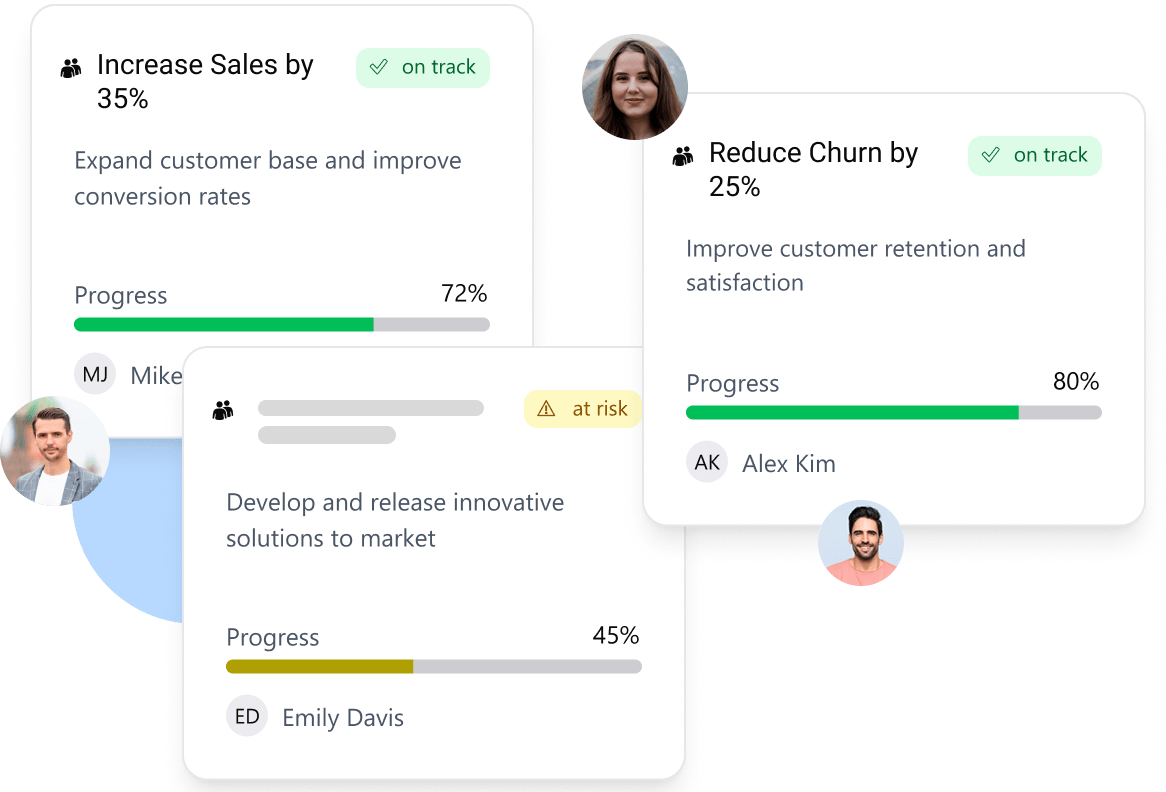Trusted by top companies to improve employee performance, engagement, and retention.












OKR software is a tool designed to support the Objectives and Key Results (OKR) methodology—a framework used to set and track goals. It typically includes features like goal-setting templates, progress tracking, collaboration options, and performance reporting.
The software helps organizations improve goal clarity, maintain alignment across teams, and monitor outcomes more effectively throughout a given period.

| Without OKR Software | With PeopleGoal OKR Software |
|---|---|
| Goals set once, then forgotten | Goals are updated weekly & stay relevant |
| Employees are unclear on priorities | Everyone sees how they contribute |
| Endless check-in emails & reminders | Automated nudges and smart check-ins |
| Progress tracked in scattered docs | Live dashboards show it all at a glance |
| Siloed teams chasing different targets | Company-wide alignment in one system |
| Performance reviews feel subjective | Results are tied to measurable goals |
| Managers stuck in status meetings | More time coaching, less time chasing |
With the right OKR software, you can build a results-driven culture where every employee understands how their goals tie into broader company objectives. Set clear, measurable OKRs at the company, team, and individual levels to unify everyone around shared outcomes. This clarity boosts focus, accountability, and alignment across your organization from the top down.
Avoid siloed work and disconnect between strategy and action. With objectives and key results software, you can easily cascade high-level goals into department and team OKRs. Each key result can become a sub-objective for a functional group, giving them ownership and clarity. This structured flow ensures that no work is done in isolation and everyone understands how their effort supports larger business outcomes.

With built-in check-ins and visual status updates, the best OKR tracking software lets your team respond quickly to changing priorities and roadblocks. Automate weekly updates, reflect on outcomes, and maintain goal momentum throughout the quarter. Real-time feedback loops keep employees engaged, while managers can step in proactively to offer support when goals fall off track.
Your workflow is unique. That’s why you need the most flexible OKR management software on the market. From custom naming conventions to tailored review cycles, your teams can work the way that suits them best. The system integrates with existing tools like BambooHR, Workday, Azure AD, and Excel, allowing seamless data migration and easy onboarding across all departments.

Empower Agile teams to focus on outcomes, not just output, by connecting their daily work to strategic priorities. With an OKR software, sprint goals and Scrum ceremonies can be directly aligned to measurable business objectives, ensuring that every iteration moves the company forward. This alignment helps product roadmaps stay grounded in high-level strategy, turning backlog items into meaningful contributions.
Get live dashboards and downloadable reports that help teams, departments, and executives stay informed. You’ll see exactly which objectives are advancing and which ones need support through a smart OKR management tool. With this level of transparency, leadership can make smarter, faster decisions and continually optimize performance at scale.
Start with high-level company objectives that provide direction and purpose for the entire organization.
Break down company objectives into clear departmental and team goals, ensuring complete alignment across all levels.
Allow employees to create OKRs that align with company goals, ensuring individual ownership and accountability.
Leverage OKR tracking software to monitor progress in real-time, making necessary adjustments to stay on target.
At the end of each OKR cycle, conduct a thorough review, reflect on results, and refine goals for continuous improvement.
Implement single sign-on strategies like SAML, IdP, OKTA, One-Login, Microsoft Azure, and more.
Define custom roles and permissions for app and workspace levels, enabling unprecedented control.
SLA agreements, including help with support, implementation, delivery, and custom applications.
Connect with over 500 platforms like ADP, WorkDay and more. Use our SFTP service or API to build your own.
Build or browse apps tailored for your workspace. Customize everything from design to functionality.
Be notified in advance of upcoming releases, and control your own release cadence with custom apps.
See a full activity log for every text input, item, app, or workspace. Everything is logged & tracked.
Encrypted database at rest and SSL, as well as RBAC, ensures your data is secure. Continuous backups available.
Define custom reports, including charts, metrics, and custom analysis. Send data to your own BI tools.
Implementation is quick and streamlined. Most organizations go live within 1 to 4 weeks, depending on size and structure. Our team helps configure your account, import users via Excel or HRIS integrations, and provide tailored training for admins and employees to ensure fast adoption.
They can be, but it depends on how you apply them. Some companies use OKRs as part of mid- or end-cycle reviews, especially in sales or goal-driven roles. Others use them strictly for development and alignment. PeopleGoal lets you customize your approach to suit your culture, keeping OKRs aspirational, developmental, or evaluative as needed.
With a dedicated OKR tool like PeopleGoal, you gain:
See More
Less FAQs
We are building a 100-year company with a mission to DELIGHT customers. People think we’re crazy to offer phone, chat, and email support. We still do it. When it comes to awesome support & building delightful software, we go the distance - try it, and you will love it.